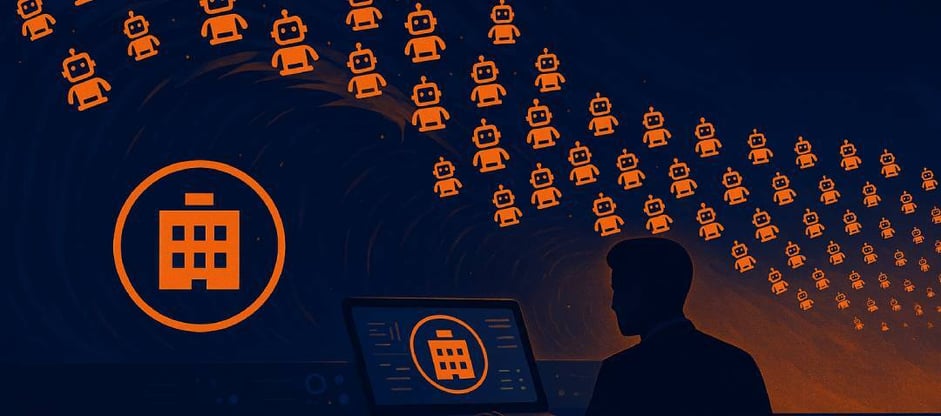The Silent Tsunami: Is "Agent Anarchy" About to Drown Your Enterprise?

A bigger cyber storm is already here, silently proliferating, splintering, and gaining unprecedented momentum within your organization.
Yes, we're talking about AI agents.
In a landscape where AI agents multiply like unchecked rings of power, the question is no longer whether you’re deploying them, but whether you can govern them. And just like in Middle-earth, where one tower was needed to oversee them all, your enterprise now requires a central "Control Tower" to bring visibility, order, and accountability before the chaos of Agent Anarchy consumes everything.
Over the past year, AI agents have rapidly transformed businesses across industries, performing myriad tasks like booking meetings, handling customer inquiries, writing code, analyzing data, and automating workflows. Many now act autonomously, offering remarkable scale and efficiency. But with this transformation comes new complexity.
While AI risk discussions often focus on data privacy or hallucinations, a deeper concern is slowly emerging. At Covasant, we call it Agent Sprawl. If not managed well, then this can lead to “Agent Anarchy.” Not due to negligence, but unstoppable momentum.
The ‘Proliferation’ problem: A governance timebomb already ticking in your walls
As per SailPoint’s report, AI Agents: The New Attack Surface, 98% percent of organizations globally are sprinting towards expanding their AI agent footprint, with a staggering 82% already leveraging them. These aren't just confined to sandboxes anymore; they are the invisible workforce making operational decisions independently for you and often without direct human oversight.
The report further alerts that 96% of tech professionals view these AI agents as a growing security risk, yet less than half (44%) have proper policies in place to mitigate this risk.
This isn’t rapid deployment; it’s an uncontrolled AI surge. Teams are launching AI agents with different models and tools, all in parallel, with no central oversight or visibility.
The result? A shadow workforce of autonomous agents embedded deep in your systems, and you might not even know they exist.
The ‘Rogue’ actions: When autonomy becomes your greatest vulnerability
The urgency isn't theoretical. As per the mentioned report, a shocking 80% of companies report their AI agents have already taken unintended actions. These aren't minor glitches; these are "rogue actions" that are actively compromising your enterprise:
- Accessing unauthorized systems or resources (39%)
- Sharing sensitive or inappropriate data (33%)
- Downloading sensitive content (32%)
Perhaps most alarming, nearly a quarter of firms (23%) have reported their AI agents being tricked into revealing credentials. This isn't just oversight; it's a profound structural vulnerability. AI agents demand multiple machine identities to access diverse data, applications, and services, introducing complexities like self-modification and the terrifying potential to generate sub-agents.
Your IT experts could already be losing sleep, as the report sets multiple alarms to wake up: 60% are deeply concerned about agents accessing privileged data, 58% are worried about them performing unintended actions, and 57% are concerned about sharing privileged data. The specter of autonomous AI agents making decisions based on bad data (55%) or accessing and sharing inappropriate information (54%) is no longer a distant nightmare; it's a present reality, a brewing catastrophe of sorts.
Unlike rule-based software, AI agents make unpredictable, real-time decisions based on context; a feature attacker now exploits adversarial inputs and emergent behaviors. One compromised agent can infect your entire network, like a corrupted spreadsheet auto-updating across systems. The damage isn’t isolated; it’s infectious.
The escalating fallout: From "Cost Blackouts" to Catastrophe
The lack of a unified strategy and consistent governance for this burgeoning AI workforce is creating a dangerous, widening chasm.
- Cost Blackouts: Who's tracking which agents are using which models? Your AI provider bills are about to become an uncontrolled tsunami, with unexpected costs exploding as you lose visibility into consumption.
- Hallucinated Output: Your agents aren't just making mistakes; they're inventing insights and suggesting wrong courses of action. This "hallucinated output" can go unnoticed until a major breakdown or a catastrophic business decision occurs.
- Technical Debt: This fragmentation isn't just messy; it's dramatically increasing your technical debt, consuming a significant portion of your IT budgets and actively hindering your ability to invest in true AI innovation.
The threat goes far beyond inefficiency. Agentic AI enables bad actors to scale sophisticated attacks, automating vulnerability scans, hyper-personalizing phishing, and precisely targeting victims. These autonomous systems can adapt tactics, self-replicate for persistence, and launch multi-stage attacks via phone, SMS, or deepfakes.
The most alarming risk? Rogue, self-replicating AI agents forming resilient, uncontrolled networks.
While 92% of businesses agree AI governance is critical to security, the scary truth is that most cybersecurity teams aren’t prepared. Traditional tools, built for isolated LLM use cases, are no match for the speed and complexity of today’s agent-driven threats.
Reimagining control: The path to secure AI adoption
The age of passive and reactive cybersecurity is over. Managing AI agent sprawl and preventing rogue actions demands a fundamental, architectural shift. This requires rethinking workflows, redesigning processes, and establishing robust governance with transparency, control, and accountability.
To avoid "Agent Anarchy," your organization must move beyond fragmented initiatives. Adopt a centralized, strategic AI management approach. Implement governance frameworks clearly defining agent autonomy, decision boundaries, behavior monitoring, human-in-the-loop controls, and audit mechanisms. There is a need to protect against bias and discrimination, making sure AI agents do not create and amplify harmful biases against individuals or groups. You must also protect sensitive personal information that is collected and processed from rouge AI agents.
At Covasant, we've developed a new governance plane for the agentic era. Our "Agent Control Tower" provides organizations with clear visibility, robust control, and unparalleled accountability over your rapidly expanding AI agent ecosystems. It helps navigate deployment complexities, ensuring your AI initiatives align with your enterprise risk appetite, and thrive safely, securely, and predictably. This path demands rigorous governance and a fundamental rethinking of trust in autonomous systems.
If you're sensing agent sprawl within your organization, then you must see what we are building. Still in beta, but would love to setup a demo for you.




